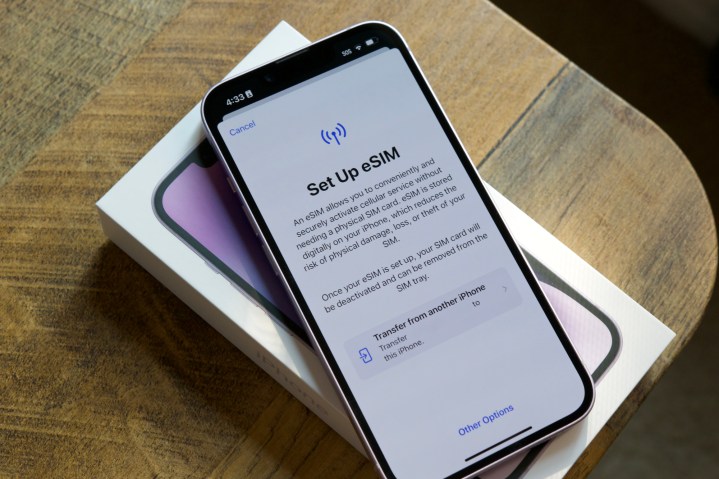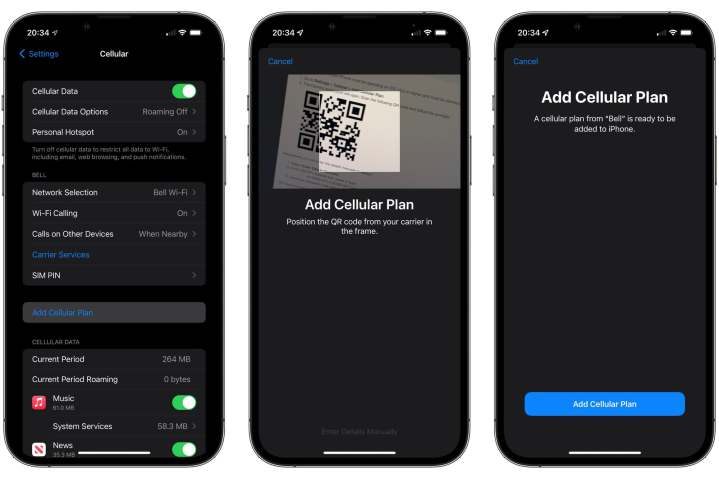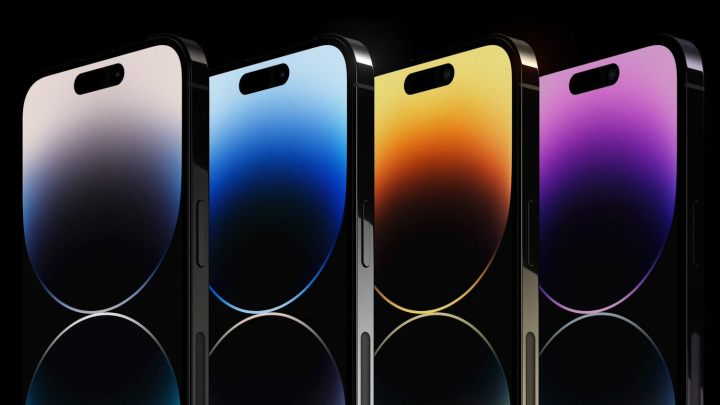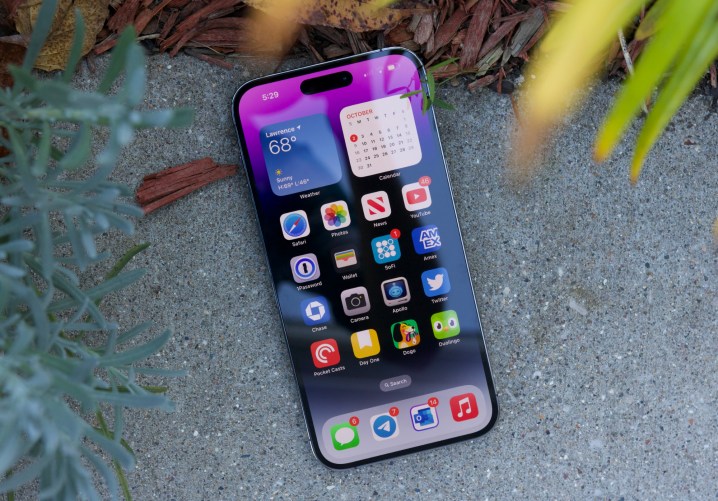
If you’ve purchased a new cell phone in the past decade or so, you’re probably already familiar with the SIM—the little thumbnail-sized card that’s used to connect to your your carrier’s cellular network —but in recent years smartphone manufacturers and carriers have started replacing them with something called an eSIM.
The “e” in eSIM stands for “embedded,” which makes sense as this is a SIM card that stays inside your phone and can’t be removed. It performs the same function as a traditional SIM card but has the potential to make things a lot simpler for most smartphone users. Almost any new phone you buy nowadays features eSIM technology, including the new iPhone 15.
Read on as we get more specific about what eSIM technology truly is, and how it differs from its predecessor, the physical SIM card.
What is an eSIM?

An embedded SIM, also known as an eSIM, is a SIM card that’s built into your smartphone and can’t be removed. It performs the same function as a traditional SIM, except that it’s programmable and physically connected (soldered) to your smartphone’s motherboard.
This may seem problematic at first glance. For instance, when traveling abroad using phones with removable SIM cards, you can swap to another carrier’s SIM card to get local coverage and avoid paying roaming fees from your primary carrier. Likewise, if you want to switch local carriers but keep your phone, a removable SIM card can be popped out and easily replaced with a new one in seconds. Your first impression may be that this is impossible with an eSIM.
However, eSIM technology actually makes switching carriers even easier, at least in theory. Instead of waiting for a new SIM card to ship or making a trip to a local store to pick one up, you can make the switch right on your phone by entering information from your carrier — often just by scanning a QR code with your smartphone’s camera. If your smartphone has an eSIM inside, you’ll find options in the settings that allow you to configure your eSIM, switch between lines and carriers, and manage your accounts. If you’re a dual-SIM user, eSIM technology may even support multiple accounts — and switching between them is super easy.

Unfortunately, while getting an eSIM should be easier than obtaining a physical SIM, that’s not always the case. Some carriers have taken longer than others to embrace the seamlessness of eSIM, and it’s not uncommon to encounter a few that still want to mail you your eSIM codes or have you visit a store before you can set up your phone. That takes away one of the biggest advantages of using an eSIM, but thankfully most carriers are working quickly to catch up with the times.
The other significant benefit of eSIM technology is the space saved by removing a physical SIM tray. Devices can be smaller because the eSIM chip is embedded in the device’s motherboard — there’s no unnecessary space taken up by placing a slot and tray on the outside edge of the device. This allows for thinner designs and larger batteries. It also helps with improving water resistance by eliminating another place where moisture can get inside your phone.
Devices with eSIM technology

All of the major phone manufacturers now offer eSIM technology in their phones: Apple iPhones have it (including, of course, the recently released iPhone 15), Samsung Galaxy devices have it, Google Pixel phones have it, and flagship Motorola phones have it. If you buy a new phone, chances are strong you’ll have eSIM functionality in the palm of your hands. Many tablets and watches include eSIM technology too, including Apple Watches and iPads.
Speaking of Apple, all iPhones from the iPhone 13 on offer support for using two eSIM cards, letting users get dual-SIM support without the need for a physical SIM card. In fact, Apple removed the physical SIM card slot entirely for the U.S. models of the iPhone 14 lineup, making eSIM the only way to get your iPhone 14 activated on a carrier network.

iPhone 14 models sold in most other countries still include two eSIM cards and one physical SIM card slot, the same as the iPhone 13. The notable exception to this rule is China, where eSIM has never been included on an iPhone. Instead, when Apple debuted the iPhone XS/XR in China, it provided two physical SIM card slots. That practice has continued to this day.
However, if you’re in the U.S. and want a physical SIM card slot on your iPhone 14, there’s one thing you’ll want to keep in mind before hopping up to Canada or down to Mexico to do a little cross-border shopping. Although all North American iPhone models support the same 4G/LTE, low-band 5G, and mid-band 5G frequencies, only the U.S. iPhone models support the mmWave 5G used for the fastest portions of Verizon’s 5G Ultra Wideband and AT&T’s 5G Plus coverage.
When can I start using an eSIM?

Chances are, your mobile device already has an eSIM card, as we’ve outlined above. Laptops with cellular connectivity mostly connect using eSIM technology, like the Surface Pro X and various models from Acer, Asus, Dell, HP, Lenovo, and Samsung. You will still see cases where SIM cards are employed in laptop designs, but that’s becoming far less common.
Until eSIM tech becomes the universal standard, many phones will still have a tray designated for a removable SIM card. There’s nothing wrong with using one of these phones — it’s just an older means to identify you on a carrier’s network. Still, swapping out a SIM card can be troublesome, given its size and delicate do-not-touch circuits. Managing an eSIM is easier for everyone, whether you’re switching phones or moving to another carrier.
If you’re using a dual-SIM phone with both a physical SIM card and eSIM, such as an iPhone or Google Pixel, you may also be able to transfer your physical SIM information directly to your eSIM. Many carriers allow for this, and iOS and Android provide tools to make it quick and easy. Once that’s done, you can toss your old SIM card aside and free up that slot for a physical SIM card for traveling.
Nevertheless, while you’ll want to check ahead, you may be pleasantly surprised to find how many international carriers support eSIM, and it’s hard to argue that it’s much easier to scan a QR code than trying to fiddle with swapping out a small and fragile SIM card, especially when traveling through a busy airport.
Frequently Asked Questions
What is an eSIM and how does it work?
An eSIM is an embedded SIM card that lives inside your phone, making it distinct from a traditional SIM card, which can be physically removed from your phone. An eSIM performs the same function as a physical SIM: it allows you to connect to your carrier’s cell phone network and plan.
What is the disadvantage of eSIM?
On its face, the disadvantage of eSIM technology is that because it can’t be physically removed, quickly swapping out SIM cards when you’re traveling to get local coverage from a different carrier is a harder thing to do. In actuality, it makes switching carriers even easier, since switching to a new SIM is as easy as scanning a QR code from your phone.
Why would someone use an eSIM?
The reason someone would use an eSIM is that it enables easier switching between carriers. Instead of delicately swapping out easy-to-lose (or damage) physical SIM cards, all you have to do is scan a QR code to get coverage from a different carrier. Switching your cell phone carrier, data, or plan is all handled via software.
Editors’ Recommendations
Services Marketplace – Listings, Bookings & Reviews
